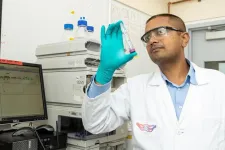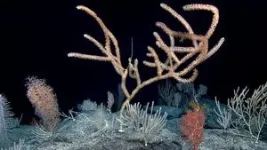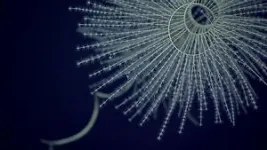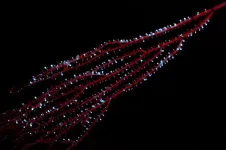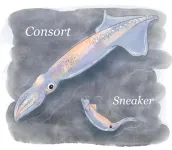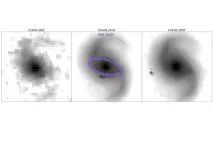(Press-News.org) Vaccines remain the gold standard of protection against dangerous pathogens, but take considerable time and vast resources to develop. Rapidly mutating viruses such as SARS-CoV-2 can blunt their effectiveness and even render them obsolete.
To address these gaps, a multi-university team led by New Jersey Institute of Technology’s Vivek Kumar is developing a hydrogel therapy that acts as a first line of defense against viruses and other biological threats. The peptides that make up this gel prevent viruses such as SARS-CoV-2, which causes COVID-19, from attaching to and entering cells. They do this by binding to a particular receptor on the invading pathogen while also aggregating into a multilayer “molecular mask” that muffles its action.
Over the course of their research, the team discovered that the molecular mask alone prevented infections. The potential advantage of this new technology, they say, is its ability to combat diverse pathogens and disease mutations.
“Protecting people in the initial phases of an outbreak is important,” said Kumar, an associate professor of biomedical engineering. “Our new mechanism could also help first responders on the front lines, military personnel encountering novel pathogens, people in remote, under-resourced areas and those who are unable to receive vaccinations.”
The near-term goal is to produce a nasal spray against airborne infections.
In a recently published study in the journal Nature Communications, the team described how the mask binds non-specifically with its target. It is composed of computationally designed peptides (strings of amino acids that form proteins) that self-assemble into nanoscale fibrous hydrogels. By comparison, antibodies produced by vaccines target particular receptors, as the mRNA vaccines developed during the pandemic that bind with specific proteins on the SARS-CoV-2 spike.
The team’s discovery arose from research at the outset of the pandemic on new approaches to prevent the virus from invading cells. The initial design, involving peptides that targeted the SARS-CoV-2 spike, looked at highly specific domains. However, the non-specific peptide gels they also designed formed a multi-layer fiber on top of the virus. The group has postulated that the negative charges in the fibers interact with differently charged proteins on the viral surface, masking them, and thus preventing them from interacting with native cells.
Of the non-specific protein mask, Kumar noted, “It forms a larger structure and better binding than a single molecule does. While it doesn’t have high specificity, it can self-assemble and stay on the target longer, forming a fiber sticker on the surface that acts like molecular Velcro.”
He added, “The goal would be a topical agent that binds to the virus. In the case of SARS-CoV-2, we would spray it into the nose, which is a major site of infection, perhaps even prophylactically.”
The team first tested the fibers against a number of viruses through computer simulations that employed powerful NVIDIA graphic cards, which are commonly used in competitive gaming. They later conducted successful safety tests with mice and rats, using injections and nasal sprays, said Joseph Dodd-o, a Ph.D. student in Kumar’s lab who conducted much of the research on the therapy along with Abhishek Roy, also a Ph.D. student. The therapy inhibited the Alpha and Omicron variants of SARS-CoV-2 in vitro, lasting for a day without harming the animals in the tests in vivo.
Kumar has developed hydrogels for a number of therapeutic applications. His delivery mechanism is customizable and composed of Lego-like strands of peptides with a bioactive agent attached at one end that can survive in the body for weeks and even months, where other biomaterials degrade quickly. Its self-assembling bonds are designed to be stronger than the body’s dispersive forces; it forms stable fibers, with no signs of inducing inflammation.
The hydrogel is engineered to trigger different biological responses depending on the payload attached. Kumar’s lab has published research on applications ranging from therapies to prompt or prevent the creation of new blood vessel networks, to reduce inflammation and to combat microbes.
“In this case we’re using electrical charges that interact with the pathogen to disrupt it,” Kumar said. “We’re still trying to determine how the fibers interact: Is this a mechanical mode of action? Drug resistant pathogens mutate around biochemical modulators, but are they less likely to mutate around a mechanical spear? By understanding this fundamental interaction, we want to figure out how to use it against different diseases.”
In new studies, the lab is testing the therapy against drug-resistant bacteria and fungi.
Members of the team bring varied expertise: computational design at The University of Illinois Chicago; bioanalytical capabilities at Georgia Tech and Baylor School of Medicine; virology studies at Rutgers University; and platform, analytical and assay experience at NJIT.
Their research is funded by the National Institutes of Health, the U.S. National Science Foundation and the New Jersey Economic Development Authority.
END
NJIT engineers muffle invading pathogens with a 'molecular mask'
Researchers are developing a hydrogel therapy that acts as a first line of defense against viruses and other biological threats.
2024-04-24
ELSE PRESS RELEASES FROM THIS DATE:
Perinatal transmission of HIV can lead to cognitive deficits
2024-04-24
WASHINGTON –Perinatal transmission of HIV to newborns is associated with serious cognitive deficits as children grow older, according to a detailed analysis of 35 studies conducted by Georgetown University Medical Center neuroscientists. The finding helps pinpoint the geographic regions and factors that may be important for brain development outcomes related to perinatal HIV infection: mother-to-child HIV transmission during pregnancy, labor and delivery, or breastfeeding.
The findings appeared in eClinicalMedicine on April 23, 2024.
Mostly because of advances in antiretroviral therapies, AIDS, which is caused by HIV infection, has ...
The consumption of certain food additive emulsifiers could be associated with the risk of developing type 2 diabetes
2024-04-24
In Europe and North America, 30 to 60% of dietary energy intake in adults comes from ultra-processed foods. An increasing number of epidemiological studies suggest a link between higher consumption levels of ultra-processed foods with higher risks of diabetes and other metabolic disorders.
Emulsifiers are among the most commonly used additives. They are often added to processed and packaged foods such as certain industrial cakes, biscuits and desserts, as well as yoghurts, ice creams, chocolate bars, industrial breads, margarines and ready-to-eat or ready-to-heat meals, in order to improve their appearance, taste and texture and lengthen ...
New cancer research made possible as Surrey scientists study lipids cell by cell
2024-04-24
Imagine being able to look inside a single cancer cell and see how it communicates with its neighbours.
Scientists are celebrating a new technique that lets them study the fatty contents of cancer cells, one by one.
A study led by the University of Surrey has sampled single live cancer cells and measured the fatty lipid compounds inside them. Working with partners at GSK and UCL, and developing new equipment with Yokogawa, the team saw how those cells transformed in response to changes in their environment.
Dr ...
Bioluminescence first evolved in animals at least 540 million years ago
2024-04-24
Bioluminescence first evolved in animals at least 540 million years ago in a group of marine invertebrates called octocorals, according to the results of a new study from scientists with the Smithsonian’s National Museum of Natural History.
The results, published today, April 23, in the Proceedings of the Royal Society B, push back the previous record for the luminous trait’s oldest dated emergence in animals by nearly 300 million years, and could one day help scientists decode why the ability to produce light evolved in the first place.
Bioluminescence—the ability of living things to produce light via chemical reactions—has independently ...
Squids’ birthday influences mating
2024-04-24
The day a male spear squid hatches determines which mating tactic he will use throughout his life, according to new research. Spear squid (Heterololigo bleekeri) that hatch earlier in the season become “consorts” which fight for mating opportunities. Those which hatch later become “sneakers,” which use more clandestine mating tactics. Researchers found that the mating tactic determined by the birth date was fixed for the squid’s whole life. Understanding how mating tactics are influenced by birth date, and the environmental conditions at that time, can help researchers consider ...
Star bars show Universe’s early galaxies evolved much faster than previously thought
2024-04-24
Embargoed until 00:01am BST on Wednesday 24 April 2024/19.01pm ET on Tuesday 23 April 2024
-With pictures-
The Universe’s early galaxies were less chaotic and developed much faster than previously thought, according to new research looking back more than ten billion years in time.
An international team of astronomers led by Durham University, UK, used the James Webb Space Telescope (JWST) to find evidence of bar formation when the Universe was only a few billion years old.
Bars are elongated strips of stars found in disc or ...
Critical minerals recovery from electronic waste
2024-04-24
RICHLAND, Wash.—There’s some irony in the fact that devices that seem indispensable to modern life—mobile phones, personal computers, and anything battery-powered—depend entirely on minerals extracted from mining, one of the most ancient of human industries. Once their usefulness is spent, we typically return these objects to the Earth in landfills, by the millions.
But what if we could “mine” electronic waste (e-waste), recovering the useful minerals contained within them, instead of throwing them away? A clever method of recovering valuable minerals from e-waste, developed by a research team at the Department ...
The move by Apple Memories to block potentially upsetting content illustrates Big Tech’s reach and limits, writes Chrys Vilvang
2024-04-23
How do algorithms determine the way we interact with our memories?
It’s a uniquely 21st-century kind of question, and it is far from settled.
In a new paper in the journal Memory, Mind & Media, Concordia PhD candidate Chrys Vilvang argues that the way tech companies store, package and share personal content back to users is opaque. And, given one recent controversy, it’s open to important questions about selection and representation.
Vilvang’s paper looks at the discussion stemming from an April 2022 article on 9to5Mac, a tech news site dedicated to all things Apple. Its journalists were given access to the iOS 15.5 beta update, and they discovered ...
Chemical tool illuminates pathways used by dopamine, opioids and other neuronal signals
2024-04-23
Image
University of Michigan researchers have developed a new tool to better understand how chemicals like dopamine and epinephrine interact with neurons.
These chemicals are among a wide variety of signals that get processed in the brain through G protein-coupled receptors (GPCRs), proteins that sit on the surface of neurons to receive messages—in the forms of proteins, sugars, fats, even light—that inform cellular behavior.
GPCRs are involved in an enormous number of biological functions, making them a prime ...
Asian monsoon lofts ozone-depleting substances to stratosphere
2024-04-23
Asian monsoon lofts ozone-depleting substances to stratosphere
Airborne observations discover new link between pollution and climate
Powerful monsoon winds, strengthened by a warming climate, are lofting unexpectedly large quantities of ozone-depleting substances high into the atmosphere over East Asia, new research shows.
The study, led by the U.S. National Science Foundation National Center for Atmospheric Research (NSF NCAR) and NASA, found that the East Asian Monsoon delivers more than twice the concentration of very short-lived ozone-depleting substances into the upper troposphere and lower stratosphere than previously reported.
The research team ...
LAST 30 PRESS RELEASES:
First Editorial of 2026: Resisting AI slop
Joint ground- and space-based observations reveal Saturn-mass rogue planet
Inheritable genetic variant offers protection against blood cancer risk and progression
Pigs settled Pacific islands alongside early human voyagers
A Coral reef’s daily pulse reshapes microbes in surrounding waters
EAST Tokamak experiments exceed plasma density limit, offering new approach to fusion ignition
Groundbreaking discovery reveals Africa’s oldest cremation pyre and complex ritual practices
First breathing ‘lung-on-chip’ developed using genetically identical cells
How people moved pigs across the Pacific
Interaction of climate change and human activity and its impact on plant diversity in Qinghai-Tibet plateau
From addressing uncertainty to national strategy: an interpretation of Professor Lim Siong Guan’s views
Clinical trials on AI language model use in digestive healthcare
Scientists improve robotic visual–inertial trajectory localization accuracy using cross-modal interaction and selection techniques
Correlation between cancer cachexia and immune-related adverse events in HCC
Human adipose tissue: a new source for functional organoids
Metro lines double as freight highways during off-peak hours, Beijing study shows
Biomedical functions and applications of nanomaterials in tumor diagnosis and treatment: perspectives from ophthalmic oncology
3D imaging unveils how passivation improves perovskite solar cell performance
Enriching framework Al sites in 8-membered rings of Cu-SSZ-39 zeolite to enhance low-temperature ammonia selective catalytic reduction performance
AI-powered RNA drug development: a new frontier in therapeutics
Decoupling the HOR enhancement on PtRu: Dynamically matching interfacial water to reaction coordinates
Sulfur isn’t poisonous when it synergistically acts with phosphine in olefins hydroformylation
URI researchers uncover molecular mechanisms behind speciation in corals
Chitin based carbon aerogel offers a cleaner way to store thermal energy
Tracing hidden sources of nitrate pollution in rapidly changing rural urban landscapes
Viruses on plastic pollution may quietly accelerate the spread of antibiotic resistance
Three UH Rainbow Babies & Children’s faculty elected to prestigious American Pediatric Society
Tunnel resilience models unveiled to aid post-earthquake recovery
Satellite communication systems: the future of 5G/6G connectivity
Space computing power networks: a new frontier for satellite technologies
[Press-News.org] NJIT engineers muffle invading pathogens with a 'molecular mask'Researchers are developing a hydrogel therapy that acts as a first line of defense against viruses and other biological threats.
